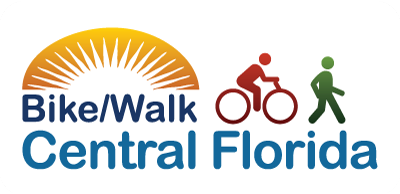This article was originally published on BWCF’s website on May 14, 2014.
We felt like Rick’s message is still relevant today, 5 years later, during National Bike Month. Since this post, several cycle tracks have been installed around Central Florida. In 2016, the City of Winter Park won the Urban Land Institute Trend Setter Award for it’s 2-way cycle track at Cady Way. Cycle tracks are also in the proposed design changes for both the Robinson Street corridor and Corrine Drive.
Along Rosalind, the City of Orlando stepped up safety measures in 2017 by painting the bike lane green. While it increases visibility (and any safety measure is a good one), it does not address the problem of parallel parkers opening doors into the bike lane.
In all, BWCF continues to support any efforts by local officials and planners to increase safety for bicyclists and pedestrians–including cycle tracks.
- Green bike lane on Rosalind Ave.
- Green bike lane on Rosalind Ave.
- Proposed changes to Robinson St. including cycle track
- Cady Way Cycle Track
“Cycle tracks buffer riders from traffic, improve safety”
 Rick Geller, a partner with Fishback Dominick in Winter Park, is a board member of Bike/Walk Central Florida. The views expressed are his own.
Rick Geller, a partner with Fishback Dominick in Winter Park, is a board member of Bike/Walk Central Florida. The views expressed are his own.
As hundreds of cyclists celebrate “Bike to Work Day” by riding to downtown Orlando with Mayor Buddy Dyer Friday morning, Dyer might contemplate an alarming statistic: per capita, Florida leads the nation in bicyclists killed on the road, according to the U.S. Department of Transportation.
But we can make day-to-day bicycling safer by adopting a simple innovation working for cities across America — the cycle track, sometimes called a protected bike lane. Rather than merely painting a thin white line on the street, cities are using parked cars, poles and raised concrete islands to separate bicyclists from fast-moving traffic. The idea is to make bicycling safer, more comfortable, and a real option for commuting and running errands.
The leading city installing these facilities, New York, built its first cycle track in 2007 on Ninth Avenue. Retail sales skyrocketed 49 percent as slow-moving cyclists patronized businesses more often than motorists zipping by to other destinations. On streets with cycle tracks, New York saw the number of cyclists more than double or triple. Yet, due to a traffic-calming effect — and because the presence of cyclists became predictable — injury crashes for all road users declined between 28 percent and 62 percent.
For comparison, during the same years, since 2007, Central Florida cyclist injuries soared 44 percent and fatalities by 34 percent. Our failure to keep pace with state-of-the-art bicycling facilities has consequences.
Chicago Mayor Rahm Emanuel saw New York’s success and embarked on building 100 miles of cycle tracks to attract young entrepreneurs and businesses. Initially resistant, Illinois’ Department of Transportation now rates cycle tracks as a “top treatment” that would “contribute to a safer bicycling environment.” My recent ride on the Dearborn Avenue cycle track, through the heart of The Loop, felt virtually stress-free.
The popularity of cycle tracks is spreading nationwide to smaller cities. St. Petersburg built Florida’s first, a segment of the future Coast-to-Coast Trail. Memphis is building 15 miles. Indianapolis’ 8-mile Cultural Trail has generated more than $100 million in downtown development. Even Jackson, Wyo., population 9,800, is building a cycle track.
Some ask about the cost of building these facilities. Cincinnati’s Central Parkway cycle track will cost about $140,000 a mile, funded mostly by a federal grant, and will enhance the ongoing revitalization of Over-the-Rhine, a neighborhood next to downtown. For only $18,000, Austin, Texas, added a buffer zone with poles between the bike and motorist lanes to build the Bluebonnet cycle track for kids biking to an elementary school. For comparison, widening 1 mile of roadway to four lanes in Central Florida generally costs between $8 million and $10 million.
Some avid cyclists oppose cycle tracks and bike lanes virtually everywhere. They point to conventional bike lanes, where parked-car doors can fling open and strike a bicyclist. On a cycle track, parked cars shield bicyclists from uncomfortable, fast-moving traffic while a striped-painted area on the street allows for safe clearance from car doors. The city of Orlando should look at upgrading Rosalind Avenue’s bike lane, in the “door zone” next to Lake Eola Park, to a cycle track to keep everyone out of harm’s way.
Local officials should also consider routes to connect to SunRail stations, parks, schools and the region’s growing trail network. To minimize conflicting movements between bicyclists and motorists, officials should look for routes with few cross streets and driveways and, near intersections, prohibit on-street parking so that bicyclists and motorists can see each other. To prevent crashes, motion-sensing traffic signals, like those in Chicago, detect bicyclists in the cycle track and direct them to proceed through an intersection before allowing motorists to turn.
Riding a bicycle can feel like pure heaven. Best yet, bicycling can reduce the risk of obesity, heart disease, stroke, diabetes and numerous other ailments. Studies find that kids who bike to school are more alert during the day and perform better.
However, to expect that most people, whether age 7 or 70, will ride in the same lanes with fast-moving cars and trucks, or even in our existing unprotected bike lanes, is unrealistic. Let’s instead create state-of-the-art bicycling facilities that are safer, more comfortable — and more tempting for everyone to use.
Copyright © 2014, Orlando Sentinel”




